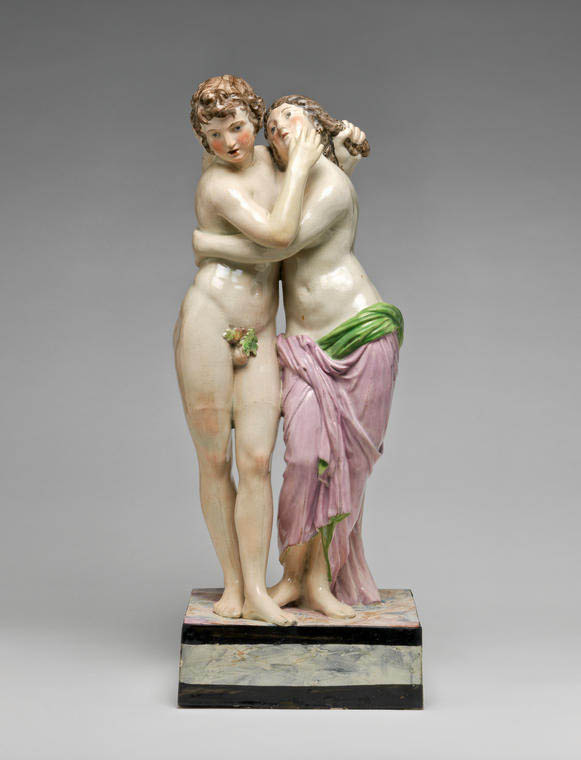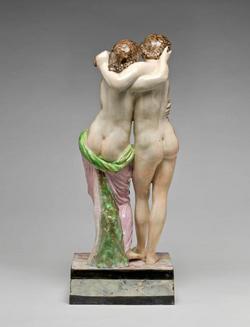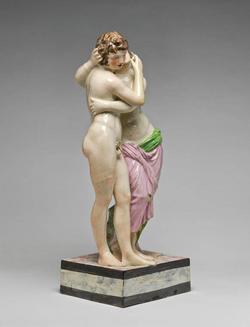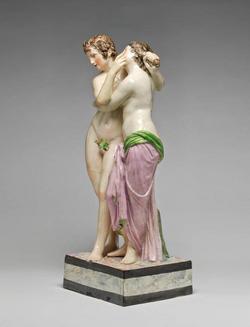Current Location: In storage
Titles
Cupid and Psyche
Maker(s)
Factory:
Wood, Enoch
(Probably)
Factory:
Wood & Caldwell
(Probably)
Entities
Categories
Description
Lead-glazed earthenware painted in enamels
White earthenware moulded, coated with blue-tinted lead-glaze, and painted in green, flesh dark pink, a little red, brown grey and black enamels.
Notes
History note: Percy Fitzgerald Collection; sold Christie, Manson & Woods, 24 January 1908, Catalogue of the earthenware collection of Staffordshire ware formed during the past forty years by Percy Fitzgerald Esq., FSA of 37 St George’s Road, S.W., part of lot 112; Dr J.W.L. Glaisher, FRS, Trinity College, Cambridge
Legal notes
Dr J.W.L. Glaisher Bequest
Measurements and weight
Height: 51.8 cm
Acquisition and important dates
Method of acquisition: Bequeathed
(1928-12-07)
by
Glaisher, J. W. L., Dr
Dating
18th Century, Late
George III
Circa
1785
CE
-
1800
CE
Note
This group was derived either from a now lost marble which was excavated by Conte Giuseppe Fede (d. 1777) at Hadrian's Villa at Tivoli, and removed to his house in Rome, or from a copy made about 1730 by Laurent Delvaux, who brought it back to England when he returned. After he had left for Brussels in 1733, Delvaux left his marble with another sculptor, Peter Scheemakers, who sold it on his behalf in 1734 to John, 4th Duke of Bedford for his country seat, Woburn Abbey, Bedfordshire. Count Fede's marble was identified as Cupid and Psyche, but because of the position of Cupid's head and right arm, later became known as 'Biblis and Caunus' or 'Salmacis and Hermaphroditus'. According to Haskell and Penny (1981) this was because of a restorer (having altered the position of Cupid's head and right hand). Later, these titles were dropped and it reverted to 'Cupid and Psyche', because of its resemblance to the embracing 'Cupid and Psyche' discovered in 1749 and placed in the Capitoline Museum. Rome. Count Fede's marble was also recorded in a red chalk drawing by Pompeo Battoni c. 1727-30, bequeathed by Richard Topham (1671-1730) to Eton College (Topham Collection, Bn3, no. 21). The pottery group was probably produced from a reduced size plaster purchased from a London cast maker. The Catalogue of Charles Harris (undated c. 1790), for example, included plasters of both 'Cupid and Psyche', and 'Salmacis and Hermaphroditus', 21 in high which sold for 2 guineas each. The pottery figures differ from the marbles in having oak leaves added to Cupid for modesty to make the group acceptable to the middle class patrons for whom it must have been intended, and for whom, according to Josiah Wedgwood, such adjustments were necessary. Copies of both Conte Fede's and the Capitoline 'Cupid and Psyche' were sometimes paired with copies of the Marbury Hall 'Bacchus and Ariadne' now identified as Priapus and a Maenad (for example on either side of mantelpiece at Ickworth, Suffolk), and it seems probable that the pottery versions might also have been displayed in pairs. See C.904-1928, a Staffordshire earthenware Bacchus and Ariadne, probably made by Enoch Wood or Wood & Caldwell.
School or Style
Neoclassical
People, subjects and objects depicted
Components of the work
Decoration
composed of
enamel
( green, flesh pink, dark pink, a little red, brown grey and black)
Base
Width 20 cm
Materials used in production
blue-tinted
Lead-glaze
white
Earthenware
Techniques used in production
Moulding
: Earthenware, moulded, with blue-tinted lead-glaze, painted in green, flesh pink, a little red, brown, grey and black enamels
Lead-glazing
References and bibliographic entries
Related exhibitions
Identification numbers
Accession number: C.944-1928
Primary reference Number: 76424
Old object number: 2894
Stable URI
Audit data
Created: Saturday 6 August 2011
Updated: Tuesday 26 March 2024
Last processed: Tuesday 15 July 2025
Associated departments & institutions
Owner or interested party:
The Fitzwilliam Museum
Associated department:
Applied Arts

 IIIF Manifest
IIIF Manifest








